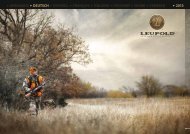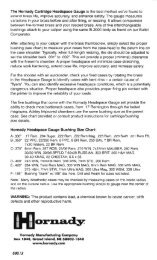2013 Leupold Sports Optics Catalog
2013 Leupold Sports Optics Catalog
2013 Leupold Sports Optics Catalog
Create successful ePaper yourself
Turn your PDF publications into a flip-book with our unique Google optimized e-Paper software.
l e u p o l d<br />
the broadest Line in the indUstry. UnsUrpassed<br />
opticaL performance. These are two hallmarks of the<br />
<strong>Leupold</strong> brand, and have been since 1907. However, there is<br />
one other trait in our DNA that is most closely associated with<br />
the <strong>Leupold</strong> name: rugged dependability.<br />
<strong>Sports</strong> optics are put to the test each time they go into the field. Harsh and changing weather conditions.<br />
Travel over unforgiving terrain. And the relentless pounding of recoil associated with centerfire rifles.<br />
This is not a place for the meek or the mild.<br />
That’s why our optics must pass the industry’s most torturous testing program before they are ever<br />
deemed ready to accompany you on your hunt or competition.<br />
And that’s your assurance that your hard-earned investment will be there when you need it.<br />
Understanding<br />
the LangUage<br />
of optics.<br />
lighT Transmission<br />
Chances are you’ve heard that scopes “gather light” or “scopes with larger<br />
objectives gather more light.” In reality, scopes do not “gather light,” but rather<br />
“transmit it.” The lenses in your scope channel the available light into a beam<br />
and direct it to your eye. How much of that usable light is transmitted to your<br />
eye determines the brightness (and the quality) of the picture you see.<br />
exiT PuPil<br />
The exit pupil of a scope is the circle of light containing the image of the object<br />
being viewed as it leaves the scope through the eyepiece. To find the diameter<br />
of the exit pupil (in millimeters) divide the objective diameter of the scope<br />
(in millimeters) by its magnification level. A 50mm objective scope set at 10x<br />
would offer an exit pupil of 5mm in diameter. Place your eye the proper distance<br />
from the eyepiece (optimal eye relief) and the full field of view of the scope will<br />
be seen. The exit pupil also has an effect on how “bright” an image appears<br />
(see Total Light Throughput ).<br />
ToTal lighT ThroughPuT <br />
The visible brightness differences from one scope to another are due to a variety<br />
of factors, but NONE more important than the exit pupil. The human eye has a<br />
pupil dilation range from about 2mm in bright sunlight to 7mm in darkness.<br />
In order to get the full potential from a scope, the exit pupil needs to match<br />
the pupil dilation of the eye. A 40mm objective on 10x will have a 4mm exit<br />
pupil, an area of 12.6 square millimeters…well suited for early morning or<br />
evening shooting. A 50mm objective would increase the exit pupil to 5mm, an<br />
area of 19.6 square millimeters. This represents a 56% increase in Total Light<br />
Throughput. On some optics, such as a fixed power 4x33mm, the exit pupil is<br />
more than 8mm…your eye is awash in light and the image is incredibly bright.<br />
So, the advantage of a large objective is that it increases the exit pupil size at<br />
higher magnifications.<br />
eye relief<br />
The space between your eye and the scope’s eyepiece. Ample eye relief keeps<br />
your eye a safe distance from the scope during recoil.<br />
resoluTion<br />
A crisp, finely detailed image. Without good resolution, the remaining optical<br />
elements are useless.<br />
conTrasT<br />
The best indicator of proper light management. Resolution and light<br />
management (often mistakenly called light gathering) enhance contrast while<br />
glare degrades it.<br />
4<br />
The Punisher—Dishing iT ouT. over anD over anD over again.<br />
We built the most advanced recoil test center in the world, featuring machines<br />
that can be calibrated to replicate the impact of nearly any kind of rifle on earth.<br />
We call it, “The Punisher.” We also measure the stress on the scope throughout<br />
the impact cycle, which helps us design scopes that are rugged, yet extremely<br />
lightweight. Our standard test? 5,000 impacts at 750 G forces—the equivalent<br />
of a .375 H&H Mag. rifle.<br />
imPacT shifT TesTing—sTeaDy as she goes.<br />
Once impact testing is completed, a <strong>Leupold</strong> QC technician places the scopes<br />
on the Frame Grabber. This machine tests whether or not the point of impact<br />
has shifted after 5,000 rounds of punishing abuse. Our impact testing protocols<br />
are the most stringent in the industry. You get the confidence of knowing your<br />
aim point will be rock steady shot after shot.<br />
Thermal shock/exPosure TesT—a shock To The sysTem.<br />
During our Thermal Shock Test, we rapidly heat and freeze the scopes to<br />
determine if they will fog or condense in real-world conditions. Then we subject<br />
the scopes to the Thermal Exposure Test, baking and freezing the scopes again<br />
to check all moving parts for proper operation. Both are critical to our promise<br />
of delivering 100% waterproof, shockproof, and fog proof performance.<br />
The Dunk Tank—Performance unDer Pressure.<br />
To test our scopes’ waterproof seals, every <strong>Leupold</strong> is placed in a specially<br />
designed and manufactured tank filled with 120° water. As the scopes are<br />
submerged, a vacuum is generated that makes the pressure inside the scope<br />
tubes greater than the pressure outside. Any flaws in the waterproof seals will let<br />
tiny bubbles of gas escape. Your <strong>Leupold</strong> will be 100% waterproof. Guaranteed.<br />
Tell us your sTory.<br />
We often receive letters and emails from hunters and shooters telling us how<br />
their <strong>Leupold</strong> optic survived—and performed—in the field. If you have an<br />
interesting story or a photo to share, tell us about it at www.leupold.com. 5
















